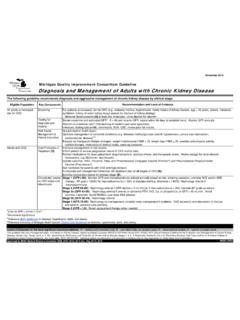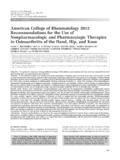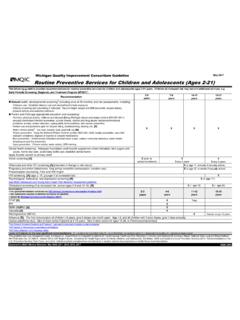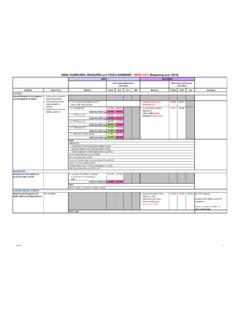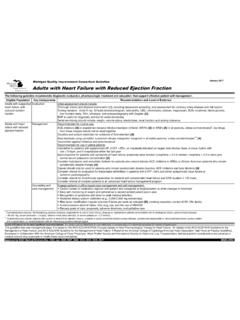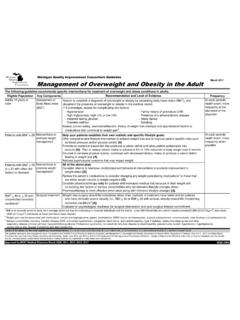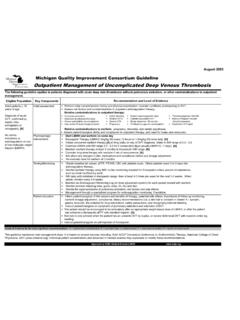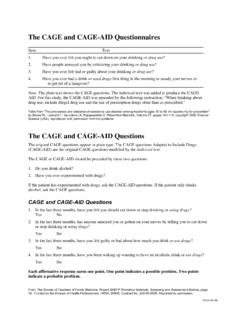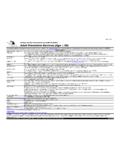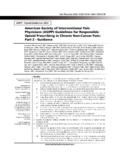Transcription of Opioid Prescribing in Adults Excluding Palliative …
1 November 2017 Key ComponentsAvoid starting opioidsScreen for risk of dependence using an instrument such as SOAPP-R orORT. When starting re-evaluate pain and function (consider using an assessment tool such as PEG-3); consider re-checking MAPS and urine drug screen. [A4]Continue Opioid therapy only if there is clinically meaningful improvement in pain and function that outweighs risks to patient safety. [A4] Reassess known risks and realistic benefits throughout Opioid therapy, including patient and clinician responsibilities for managing therapy. [A3]If benefits of therapy do not outweigh potential harms, optimize other therapies and work with patient to taper opioids to lower doses or to discontinue.
2 (A4]Consider a formalized treatment plan1 including informed consent and/or an Opioid treatment agreement (controlled substance agreement). [B4]Use urine drug testing to assess for prescribed medications as well as other controlled or illegal substances. [B4] Absence of prescription medication may indicate diversion. Perform testing at least annually, more frequently (every 3-6 months) if considering increasing dosage to 50 MME/day, reassess evidence of individual benefits and risks. Avoid increasing dosage to 90 MME/day, carefully justify and document the decision. [A3] Consider referral to a pain renewal without clinical reassessment. [B4]Manage or refer based on: physician comfort treating substance use disorder, patient willingness to be referred, availability and coverage.)
3 Use evidence-based treatment,Approved by MQIC Medical Directors Nov. 20171 NIH National Institute on Drug Abuse Sample Patient Agreement FormsThis guideline lists core management steps. It is based on Dowell D, Haegerich TM, Chou R. CDC Guideline for Prescribing Opioids for Chronic Pain United States, 2016. MMWR Recomm Rep 2016;65(No. RR-1):1 49. Individual patient considerations and advances in medical science may supersede or modify these recommendations. Recommendation categories: A = Applies to all persons; most patients should receive the recommended course of action; B = Individual decision making needed; different choices will be appropriate for different patients.
4 Clinicians help patients arrive at a decision consistent with patient values and preferences and specific clinical type: 1-Randomized clinical trials or overwhelming evidence from observational studies; 2-Randomized clinical trials with important limitations, or exceptionally strong evidence from observational studies; 3-Observational studies or randomized clinical trails with notable limitations; 4-Clinical experience and observations, observational studies with important limitations, or randomized clinical trials with several major limitations. usually medication, plus behavioral therapy. [B4] See MQIC Screening, Diagnosis and Referral for Substance Use Disorder guidelineIf continuing opioids, or adjusting doseIdentify Substance Use DisorderPrescribe the lowest effective dose of immediate-release opioids and no greater quantity than needed for the expected duration of pain severe enough to require opioids; three days or fewer for acute pain; more than seven days will rarely be needed.
5 [A4] Use opioids as part of a pain management plan, that includes non- Opioid medications and non-drug therapy, as realistic goals for pain and function, and how Opioid therapy will be discontinued if benefits do not outweigh Prescribing opioids with benzodiazepines, muscle relaxants or hypnotics [A3], due to the high risk of a urine or serum drug screen at the time of starting therapy if concerned about concurrent substance use. [B4]Consider offering patient and family naloxone when risk factors for overdose are present; , history of overdose or substance use disorder, higher Opioid dosages ( 50 MME/day), or concurrent benzodiazepine use. [A4] Naloxone duration is less than an hour.
6 Following any naloxone use, patient should be seen immediately in a hospital Emergency Department. Michigan Quality Improvement Consortium GuidelineOpioid Prescribing in Adults Excluding Palliative and End-of-Life CareMME=morphine milligram equivalentsThis guideline is intended to apply to patients aged 18 years with acute or chronic pain outside of Palliative and end-of-life care. Initial Opioid exposure is associated with a substantial risk of chronic use in some patients. Opioid dependency often begins with treatment of acute pain with non-drug therapy ( , physical/behavioral modalities), and non- Opioid medications ( , NSAIDS), if possible. Opioids are rarely useful in chronic Opioid therapy only if expected realistic benefits for both pain and function are anticipated to outweigh risks to the and Level of EvidenceReview patient's history of controlled substance use.
7 Obtain a Prescription Drug Monitoring Program report, is no safe lower limit of dose or duration for Opioid use. After seven days of use, the risk of chronic use rises 3-4 with patient the risks including dependency, overdose and death, and lack of evidence of superiority to NSAIDs. [B4] Risk of death from overdose increases with daily dosage. Relative risk is almost 3x higher for high-dose vs. low-dose of death MME/day 20-49 50-99 100-199 200(50 MME/day = 50 mg/day Hydrocodone = 33 mg/day Oxycodone)Before starting opioids, assess risk of dependenc
